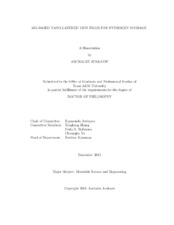| dc.contributor.advisor | Arroyave, Raymundo | |
| dc.creator | Junkaew, Anchalee | |
| dc.date.accessioned | 2014-05-13T17:23:15Z | |
| dc.date.available | 2015-12-01T06:31:12Z | |
| dc.date.created | 2013-12 | |
| dc.date.issued | 2013-11-26 | |
| dc.date.submitted | December 2013 | |
| dc.identifier.uri | https://hdl.handle.net/1969.1/151777 | |
| dc.description.abstract | Magnesium (Mg) based materials are now some of the most promising materials for hydrogen storage due to their light weight and high hydrogen capacity. Their most significant limitation, however, is the high de-hydrogenation temperature and low kinetics. Niobium (Nb) has been proposed for improving the hydrogen sorption kinetics in Mg thin films. In this work, Mg/Nb multi-layered thin films were investigated by theoretical methods and compared to experimental results. Some selected properties such as structural, elastic, energetic and electronic charge properties of the bulk and thin films have been investigated.
Firstly, classical thermodynamic models and first-principles calculations based on Density Functional Theory (DFT) were used for describing the pseudomorphic growth in Mg/Nb multi-layered films observed in experiments. Calculations of the thermodynamic, electronic and structural stability of a body-centered cubic (bcc) Mg show that this structure is in fact metastable under thin film conditions, when Mg grows epitaxially on the bcc Nb, in agreement with experiments. The predicted bi-phase diagram of Mg/Nb multilayers indicated that not only the metastable bcc Mg can be stabilized, but also a hexagonal close packed (hcp) Nb can be stabilized under the specific range of the bilayer thickness and the volume fractions of the constituents.
Next, the hydrogen desorption properties of the free standing Mg films and Mg/Nb multilayers were elucidated by DFT calculations. The computational tools were used for assisting the experimental characterization. As a result, two metastable orthorhombic magnesium hydrides (Os-MgH_(2) and Om –MgH_(2)) were observed in those films. Due to the influence of stress and corresponding formation of these metastable phases, significant destabilization of MgH2 provides ultra-low hydrogen desorption temperature in both free-standing Mg and multilayer Mg/Nb films. Formation of enthalpies (∆Hf) and estimating desorption temperatures (Td) were determined by DFT calculations and indicated that either tension or compression will lead to destabilization of MgH_(2). Moreover the hydrogen diffusion mechanisms were studied in both bulk and thin film structures. The site preference and diffusion activation energy calculations successfully describe hydrogen sorption behavior in Mg/Nb multilayers in experiments.
It is expected that the results of this research will foster further work on the development of the solid-state hydrogen storage systems necessary to bring the hydrogen economy closer to reality. | en |
| dc.format.mimetype | application/pdf | |
| dc.language.iso | en | |
| dc.subject | Mg/Nb multilayers | en |
| dc.subject | hydrogen storage | en |
| dc.subject | pseudomorphic growth | en |
| dc.subject | metastable orthorhombic magnesium hydrides | en |
| dc.subject | DFT calculations | en |
| dc.title | Mg-Based Nano-layered Thin Films for Hydrogen Storage | en |
| dc.type | Thesis | en |
| thesis.degree.department | Materials Science and Engineering | en |
| thesis.degree.discipline | Materials Science and Engineering | en |
| thesis.degree.grantor | Texas A & M University | en |
| thesis.degree.name | Doctor of Philosophy | en |
| thesis.degree.level | Doctoral | en |
| dc.contributor.committeeMember | Zhang, Xinghang | |
| dc.contributor.committeeMember | Balbuena, Perla B. | |
| dc.contributor.committeeMember | Yu, Choongho | |
| dc.type.material | text | en |
| dc.date.updated | 2014-05-13T17:23:15Z | |
| local.embargo.terms | 2015-12-01 | |


